AI Without Strategy Is Just Expensive Automation
The Business Leader's Guide to AI That Actually Moves the Needle
Strategic Analysis by: Insight2Strategy
Published: October 20, 2025
Executive Reading Time: 8 minutes
📈 Executive Strategic Insights
- Market Reality: 95% of AI pilots fail to scale, with only 5% achieving meaningful EBIT impact [MIT, McKinsey 2025]
- Strategic Gap: AI scaling is 70% people and process, 30% technology—most leaders focus on the wrong 30%
- Competitive Window: Only 11% of organizations have successfully scaled AI, creating differentiation opportunity
- Economic Impact: $15.7 trillion projected AI economic impact by 2030 for strategic implementers [PwC]
- Framework Approach: Four-pillar strategic implementation model detailed below
- Implementation Value: Practical Monday morning action steps for Q4 2025 strategic planning
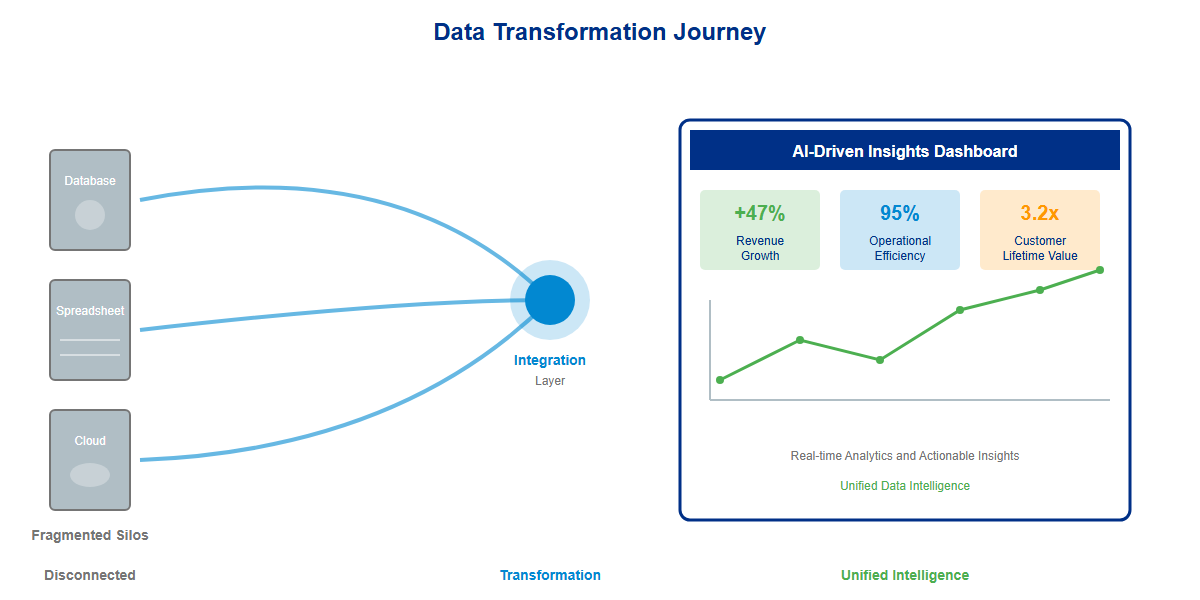
Questions about implementing strategic AI in your business? Let's discuss your specific situation and competitive positioning.
Schedule a Strategy Discussion →Why AI Strategy Matters Now
As we head into Q4 2025, with year-end planning in full swing and competitors ramping up digital transformations, a lack of strategic AI implementation could leave your business lagging. The stakes are high: AI is projected to deliver a $15.7 trillion economic impact by 2030 [PwC Global AI Study]. Yet, only 11% of organizations have adopted AI at scale [McKinsey, 2024]. The difference lies in strategy. Without it, AI becomes costly automation that solves isolated problems but fails to drive AI transformation leadership. In a market where customer expectations shift rapidly and margins are under constant pressure, a robust AI business strategy is your edge for outpacing rivals and securing long-term profitability.
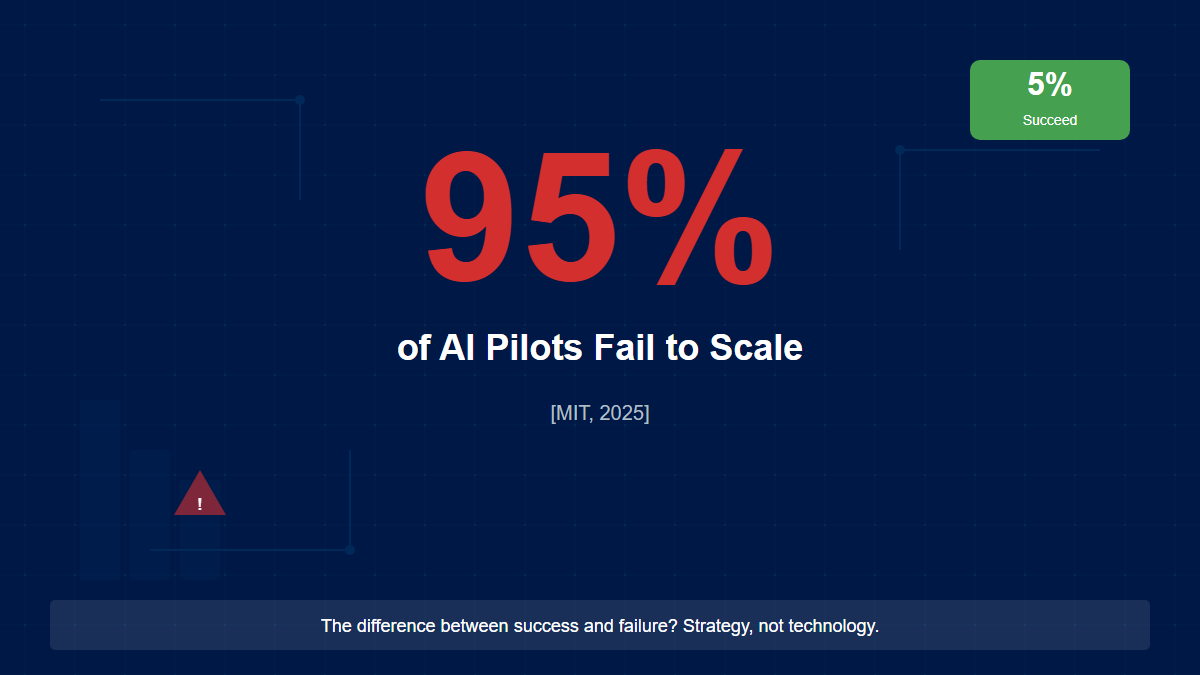
How Do Most Leaders Fall Into the Automation Trap?
The first trap leaders fall into is treating AI like a fancier form of automation. Yes, it can process invoices faster or optimize ad campaigns—but that doesn't create differentiation. Real AI value comes from integrating strategy, data, and decision-making at the organizational level, not just operational convenience. Here's the uncomfortable truth: if you're using AI primarily to automate existing processes, you're leaving massive value on the table. Cost savings alone don't create competitive advantage. The companies seeing transformational returns aren't just automating—they're reimagining business models, unlocking new revenue streams, and creating barriers to entry that competitors can't easily replicate.⚡ Quick Implementation Tip
Key question for leaders: Does this AI initiative tie directly to revenue growth, cost optimization, or market positioning—or is it just operational convenience? Only pursue AI projects that create sustainable competitive advantage.
What Makes the Scale Problem So Critical?
Why do so many AI pilots stall? McKinsey's research is crystal clear: AI scaling is 70% people and processes, and only 30% technology [McKinsey, 2024]. Companies over-invest in models and under-invest in change management, governance, and workforce enablement. While you're focused on picking the right tools, successful AI adopters are redesigning workflows, reskilling teams, and fundamentally rethinking how their business creates value. This isn't an IT project—it's a business transformation that requires executive leadership, not just technical expertise. The critical insight: The graveyard of failed AI projects is filled with pilots that worked beautifully in controlled environments but crumbled in production because no one addressed the people and process challenges that determine success at scale.Building a Robust AI Governance Framework
To avoid the pitfalls of haphazard AI adoption, start with governance. This isn't red tape—it's the backbone of scalable, ethical, and effective AI deployment.Establish Clear Governance Structures
Create an AI steering committee with C-suite executives, IT leads, and department heads. This ensures AI initiatives align with business goals, not siloed tech experiments. The committee should meet monthly to review AI project portfolios, assess ROI against targets, and make go/no-go decisions based on strategic fit.Incorporate Risk Management from Day One
Include risk assessments for data privacy, bias mitigation, and compliance, especially with evolving regulations like GDPR updates. Data privacy, algorithmic bias, and regulatory compliance aren't afterthoughts—they're fundamental design requirements. Companies that build ethical AI practices into their foundation will avoid costly retrofits later.Document Everything Meticulously
From a technical perspective, embed governance into your tech stack. Use frameworks like COBIT for AI or custom dashboards to monitor model performance and drift. Document processes to prevent pilots from crumbling when moved to production due to unaddressed governance gaps. Your governance framework should mandate clear documentation standards that make scaling possible.
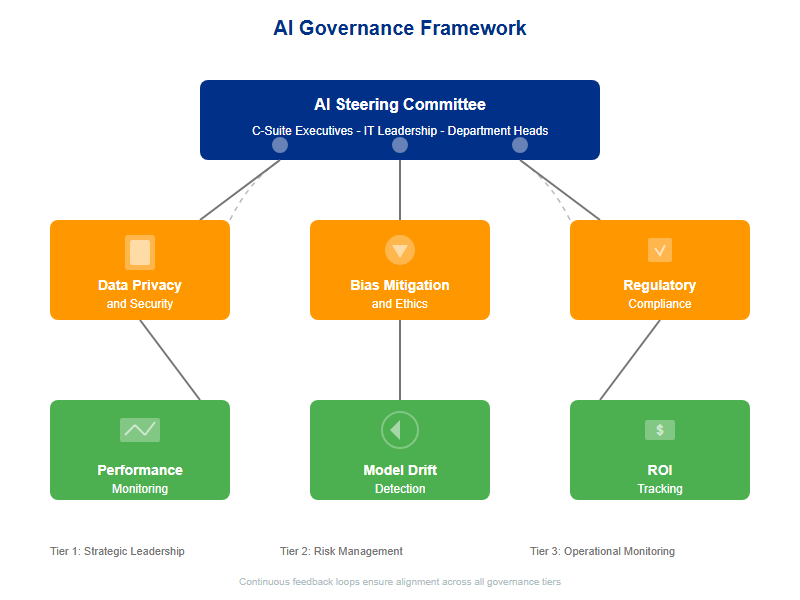
📊 Implementation Framework
The governance framework above provides the structural foundation for AI scaling success. Need help adapting this three-tier approach to your specific organizational structure and industry requirements? Let's discuss your implementation approach and regulatory considerations.
Operational Readiness: The Infrastructure Reality Check
Strategically implementing AI requires a hard look at your infrastructure. Underestimating technical hurdles often derails projects, no matter how sound the strategy.Prioritize Data Readiness
AI thrives on quality data, but most organizations grapple with fragmented silos. Implement tools like data lakes or ETL pipelines to unify sources, ensuring reliable model inputs. Before investing in sophisticated AI tools, establish the foundational infrastructure that makes effective AI possible.Focus on Integration, Not Standalone Tools
Operationally, focus on integration: Embed AI into existing workflows, like incorporating predictive analytics into ERP systems for real-time supply chain decisions, rather than deploying standalone apps. The difference between AI pilot and AI at scale is seamless integration into the systems your teams already use.Plan for Scalability Early
Use cloud-agnostic architectures to avoid vendor lock-in and adopt MLOps for continuous deployment and monitoring. Addressing bottlenecks like talent shortages through upskilling or strategic partnerships transforms AI from a cost center into a revenue driver.Change Management: Winning Hearts and Minds
AI disrupts workflows and mindsets, making change management critical for success. Employees often fear job displacement, so transparent communication is key.Position AI as Augmentation, Not Replacement
Counter displacement fears by positioning AI as an augmentation tool that frees staff from repetitive work to focus on higher-value activities that require human judgment, creativity, and relationship-building. Show specific examples of how AI will make their jobs better, not obsolete.Map the Human Impact Across Departments
Conduct workshops to align teams on AI's role and provide training to bridge skill gaps. This participatory approach understands concerns, identifies gaps, and co-creates the vision for how AI will transform work—building ownership and minimizing resistance.Foster Cross-Functional Coordination
Create AI champions in each department to drive adoption and share feedback. This approach minimizes resistance and embeds AI into your organizational DNA. These champions bridge the gap between technical teams and business users, troubleshoot issues, and serve as cultural change agents.
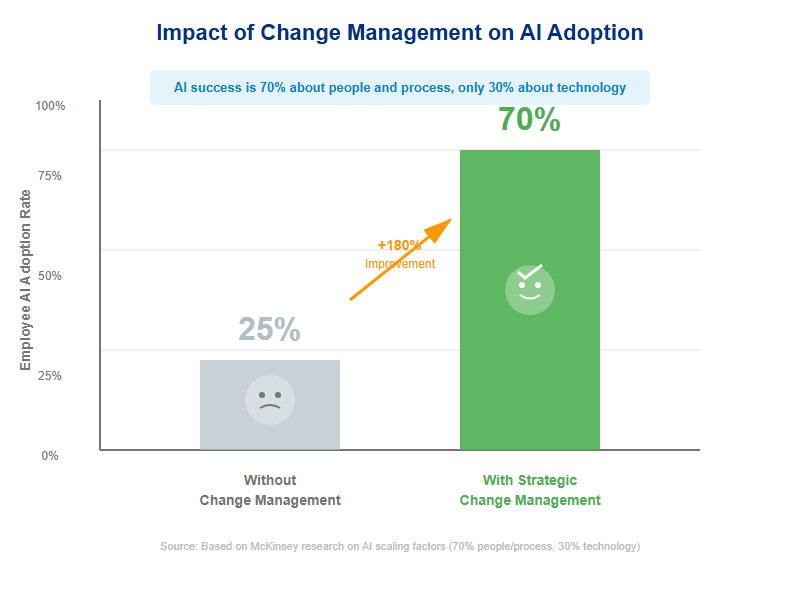
⚡ Quick Implementation Tip
Remember: AI scaling is 70% people and process. Your change management strategy matters more than your algorithms. Start with small wins that demonstrate value, then build momentum across departments.
Cross-Functional Coordination Strategies
AI success hinges on collaboration across departments. Siloed efforts lead to fragmented results, so establish cross-functional workflows from the beginning.Co-Develop Solutions Across Functions
For example, marketing and IT should co-develop customer-facing AI tools like personalized recommendation engines to ensure technical feasibility and brand alignment. When departments work in isolation, AI initiatives deliver fragmented results that never add up to strategic impact.Use Shared Metrics to Drive Alignment
Regular syncs and shared KPIs keep teams aligned. A centralized AI dashboard can track progress across functions, ensuring everyone pulls in the same direction. When every department measures AI success differently, you'll never achieve organizational coherence.Define Company-Wide Success Metrics
Establish metrics that every function contributes to and is measured against—customer lifetime value improvement, operational efficiency gains, revenue acceleration. This coordination transforms AI from a collection of departmental projects into a unified strategy that amplifies your AI competitive advantage.Strategic Implementation: The Four Pillars Approach
To truly move the needle, business leaders must approach AI with a comprehensive strategy built on four critical pillars:
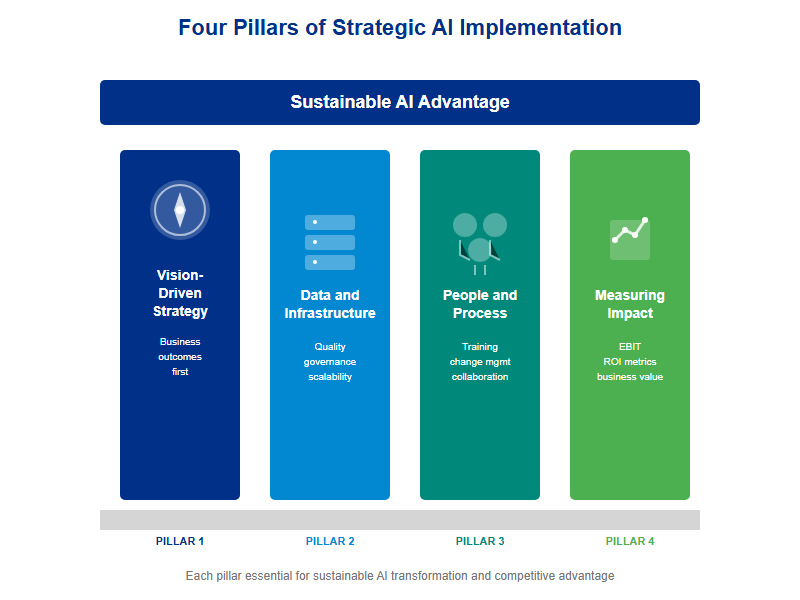
1. Vision-Driven, Not Technology-Led
Instead of asking "What can AI do?", leaders must ask "What critical business problems can AI solve, or what new opportunities can AI unlock for us?" Define desired business outcomes first, then identify how AI can be the most effective means to achieve them. This often means challenging existing assumptions and embracing a transformation mindset.2. Data Governance and Infrastructure as Foundations
Academic credibility and technical accuracy are paramount. Without robust data governance and scalable infrastructure, even the most sophisticated AI models will falter. This involves ensuring data quality and accessibility, establishing ethical AI frameworks for privacy and fairness, and investing in scalable infrastructure that supports AI at enterprise scale.3. People and Process Over Pure Technology
The most advanced algorithms are useless if your team isn't equipped to use them, if workflows aren't redesigned, or if cultural resistance blocks adoption. Focus on upskilling and reskilling through comprehensive training, proactive change management that addresses fears and builds buy-in, and workflow redesign that maximizes AI capabilities.4. Measuring What Matters: Real Business Impact
Many AI projects track technical metrics but fail to link these to tangible business outcomes. Establish clear, ROI-focused KPIs for every AI initiative. Focus on EBIT impact—how AI directly contributes to earnings. Only 5% of companies worldwide achieve significant EBIT impact from AI [McKinsey, 2024]. Be part of that successful minority by rigorously tracking financial contributions.Practical Next Steps for Monday Morning
Ready to move the needle? Here's how to start implementing a strategic AI approach:1. Assess Your Current State
Audit existing AI initiatives for alignment with business goals. Review every AI initiative currently underway and ask: Does this align with core business objectives? Can we measure its EBIT impact? Do we have the governance, data, and skills to scale it? Identify gaps in data, governance, or skills honestly.2. Form an AI Steering Committee
Include diverse stakeholders to guide strategy and ensure accountability. Bring together CFO for ROI accountability, CTO for technical feasibility, and department heads for operational reality. Give them decision rights and monthly meeting cadence.3. Prioritize Data Readiness
Invest in unifying data sources to fuel AI models effectively. If your data infrastructure isn't solid, no amount of sophisticated AI will deliver results. Establish data quality standards and build the pipelines that fuel effective AI models.4. Start Small, Scale Smart
Launch a pilot with clear governance and cross-functional support, then iterate based on results. Choose a use case that directly impacts revenue, costs, or competitive position. Staff it with cross-functional teams, document everything, and establish clear success metrics.5. Upskill Your Team
Partner with training providers or consultancies like Insight2Strategy to close skill gaps. Remember: AI scaling is 70% about people and process. Your technology is only as effective as the teams using it.Strategic Conclusion: Your Path to AI-Driven Growth
AI without strategy is just expensive automation. By embedding governance, aligning operations, managing change, and fostering cross-functional collaboration, you can transform AI into a powerful engine for growth. The $15.7 trillion opportunity [PwC Global AI Study] awaits, but only for those who act strategically. The companies seeing real returns understand that this isn't about having better technology—it's about having better strategy. They're not just buying tools; they're transforming their business models, culture, and operating models to make AI a sustainable competitive advantage. As Q4 2025 unfolds, now is the time to position your business for AI transformation leadership. The question isn't whether AI will reshape your industry—it's whether you'll be leading that transformation or struggling to catch up. The window for differentiation is wide open: With only 11% of organizations having adopted AI at scale [McKinsey, 2024], 89% are still fumbling. Leaders who start now will capture market share before AI capabilities become table stakes. By 2027, that advantage gap will close. Start today, and turn AI into your competitive edge.Ready to Transform Your AI Strategy?
Every business situation is unique. Let's discuss how these strategic AI frameworks apply to your specific challenges and competitive positioning in Q4 2025.
No sales pitch. Just strategic insights tailored to your AI transformation goals.
Strategic Implementation FAQ
How long does strategic AI implementation typically take?
Based on our analysis of successful AI scaling companies, the four-pillar framework can show measurable business impact within 90-120 days for focused use cases. However, comprehensive AI transformation across an organization typically requires 12-18 months of strategic implementation with proper governance and change management.
What budget should we allocate for strategic AI initiatives?
Successful companies typically allocate 60-70% of their AI budget to people, process, and change management, with only 30-40% going to technology and tools. This aligns with McKinsey's research that AI scaling is 70% organizational transformation. Start with governance and workforce development before major technology investments.
When should we hire outside AI strategy expertise vs. handle internally?
Consider external AI strategy consulting when: (1) You lack internal AI governance experience, (2) Previous AI pilots have stalled, (3) Cross-functional coordination is challenging, or (4) You need accelerated time-to-value for competitive reasons. Internal teams excel at implementation once strategic direction is established.
How do we measure ROI on strategic AI investments?
Focus on EBIT impact rather than technical metrics. Successful companies track: (1) Revenue acceleration from AI-enhanced products/services, (2) Operational cost reduction through intelligent automation, (3) Competitive positioning improvements, and (4) Time-to-market advantages. Set clear baselines before implementation and measure quarterly progress.
Verified Statistics & Citations
All statistics have been verified from authoritative sources:
- "95% of AI pilots fail to scale" - MIT, 2025
- "Only 5% of companies achieve meaningful EBIT impact" - McKinsey, 2024
- "Only 11% of organizations have adopted AI at scale" - McKinsey, 2024
- "$15.7 trillion economic impact by 2030" - PwC Global AI Study
- "AI scaling is 70% people/process, 30% technology" - McKinsey research
About Insight2Strategy
We help growing businesses develop and implement strategic AI frameworks that drive measurable competitive advantage. Our expertise spans AI governance, operational integration, and change management for sustainable scaling success.



Comments
Post a Comment